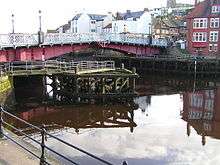Whitby Swing Bridge
| Whitby Swing Bridge | |
|---|---|
 Whitby Swing Bridge | |
| Coordinates | 54°29′13″N 0°36′46″W / 54.486914°N 0.612701°WCoordinates: 54°29′13″N 0°36′46″W / 54.486914°N 0.612701°W |
| Crosses | River Esk, North Yorkshire |
| Characteristics | |
| Design | swing bridge |
| Longest span | 75 ft |
| Load limit | 7.5 tons[1] |
| History | |
| Designer | J Mitchell Moncrieff |
| Engineering design by | Heenan & Froude[2] |
| Construction begin | 1908 |
| Construction cost | £22,582 (equivalent to £2,122,892 as of 2015),[3] |
| Opened | 1909 |
Whitby Swing Bridge is a pedestrian and road bridge over the River Esk in Whitby, North Yorkshire, England.
History
The River Esk has been crossed by bridges at this location for centuries. A grant made by King Edward III in 1351 allowed the collection of tolls for the maintenance of a bridge. By the mid 1550s the tolls averaged around £6 per annum (equivalent to £2,053 as of 2015).[3][4]
In 1629 an agreement was made by the justices in the North Riding to replace a wooden bridge with one which included moving parts. This was later replaced by a drawbridge and the first swing bridge was opened in 1833,[5] designed by Francis Pickernell.
Current bridge
By the early 20th century the limited 45-foot (14 m) clearance of the 1835 bridge was restricting the size of vessels which could be built up-stream of the bridge. A replacement swing bridge was commissioned by Whitby Urban District Council. It was designed by J Mitchell Moncrieff,[6][7] later President of the Institution of Structural Engineers. It was opened by Mabel Theresa Duncombe, the daughter of the Viscount of Helmsley and the wife of local MP, Sir Gervase Beckett. The bridge consists of two leaves moved by electric motors, though only one leaf is generally opened..
The bridge originally carried the A171 road. To avoid congestion in the town centre, the road was diverted to a high level bridge over the Esk Valley built in 1980.
The bridge is not wide enough for vehicles to pass, so vehicular access to the bridge is controlled by traffic lights.
Until 2011 the bridge had a weight limit of 17 tons. This was reduced to 7.5 tons in 2011 by North Yorkshire County Council.[1]
The bridge was featured in Episode 3 of the first season of the Amazon Prime series The Grand Tour during the "Celebrity Brain Crash" segment. Actor Simon Pegg walked across the bridge while it was opening, during which he was attacked by seagulls, resulting in him falling off and "drowning" in Whitby Harbour. The bridge was also visible in the background throughout the studio segments.
| Next crossing upstream | Esk | Next crossing downstream |
| None | Whitby Swing Bridge | A171 road bridge |
References
- 1 2 "Lower weight limit confirmed on Whitby swing bridge". North Yorkshire County Council. 18 May 2011. Archived from the original on 31 May 2012. Retrieved 25 June 2014.
- ↑ The Electrical review: Volume 69. 1911
- 1 2 UK CPI inflation numbers based on data available from Gregory Clark (2016), "The Annual RPI and Average Earnings for Britain, 1209 to Present (New Series)" MeasuringWorth.
- ↑ History and topography of the city of York: and the North riding. T. Whellan and Co. 1859
- ↑ North sea pilot. Admiralty notices to mariners. Admiralty Hydro Department. 1869
- ↑ Freeman, John. "Whitby Swing Bridge - Celebrating 100 Years of Whitby's Swing Bridge". Retrieved 2 November 2011.
- ↑ The Electrical review: Volume 69. 1911
External links
-
 Media related to Whitby Swing Bridge at Wikimedia Commons
Media related to Whitby Swing Bridge at Wikimedia Commons
